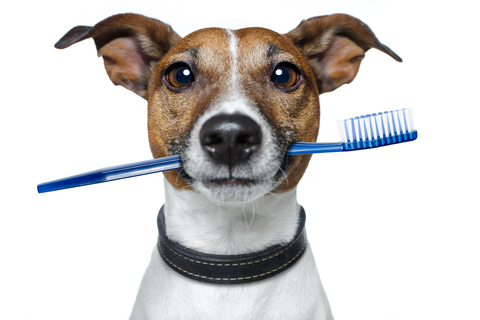One of the best things a pet owner can do to ensure the overall health of their pet is to do the routine checking of the teeth, gums and oral cavity.
Look at the two photos below — one shows a healthy state of oral hygiene and the other… well, you can see for yourself that this dog has some major problems and is in pain.
The dog whose photo is on the left runs the risk of toxin absorption into the blood stream. Bacteria, too, can invade the body through the blood stream by gaining entrance into the oral lesions. This is called bacteremia. This is also referred to as blood poisoning and septic fever. This condition becomes very dangerous when it leads to abnormally low blood pressure and high body temperature and can be fatal if left untreated.
If the bacteria gets a chance to settle and reproduce in the lining of the heart or heart valves, a serious condition may result called bacterial endocarditis. Kidney damage and joint problems are a common sequel to bacterial invasion via the unhealthy oral cavity.
What can Veterinarians do?
What if a seven-year-old dog was presented for annual vaccinations and during the physical exam the veterinarian notice the plaque on the teeth and inflamed gums at the margins of the teeth and gums?
If left to its own evolution, the dog’s gingivitis and plaque would worsen over time. The dog would eventually develop cement like tartar on their teeth, gingival recession, bacterial contamination, loose teeth and root exposure. It probably would hurt, too! That is why your Veterinarian would recommend a dental cleaning for your dog.
Typically for a dental cleaning, the dog would be admitted in the morning after an overnight fast from food and water. If the routine blood tests are normal and the dog is judged to be a good candidate for anesthesia and dentistry, we can begin the procedure. Various pre-anesthetic sedation agents are utilized, depending on the dog’s size, bloodwork and the veterinarian’s preference. After the dog is relaxed and intravenous catheter is placed, general anesthesia will be induced. An ultrasonic instrument is used to separate the plaque from the teeth. It sprays cooling water while it vibrates at an ultrasonic speed to remove the cemented debris on the teeth. After the teeth are “scaled”, a light buffing is done to polish the teeth. This smooths the surface of the teeth, so that is will help prevent other food and debris from sticking to the tooth surface.
Sometimes, an animal will need a root canal procedure performed or require a tooth to be capped. While many pet owners do not expect their pet to have these services performed, they can and should be done in certain circumstances. Gingival plastic surgery can be done, as well. Sometimes the best thing to do is to remove a severely damaged or markedly loose tooth. Once the gum heals, the pet seldom shows any signs of missing the offending tooth or teeth.
Be sure to take a good look in your dog’s (or cat’s) mouth and inspect it for any foul looking or abnormal characteristics. If you are suspicious that something isn’t right, make an appointment with your veterinarian for a dental checkup.
Both you and your pet will feel better when oral hygiene is an important part of your pet health care routine. There is no excuse for allowing a pet’s oral health status to deteriorate to conditions like the dog on the bottom. It’s up to you to keep a look-out for teeth and gum problems.
Written by Briana Taker, VA
